A new fan of ActivCore at Pilates on Fifth!
On March 13 & 14, 2010, we conducted our fifth ActivCore FEX™ Basic Course for Pilates instructors, Physical Therapists and fitness professionals. We had eight attendees in the course, and it went fabulously! We were especially happy to have Tyler Joyce, a Physical Therapist from Princeton Orthopaedic Association assisting the course as well. Below is a testimonial from one of the students.
My first encounter with ActivCore FEX was at Pilates on Fifth here in New York City. Being a former competitive swimmer, professional trained dancer, and Pilates instructor I assumed I would have enough core strength, flexibility, and muscle control to tackle the ActivCore exercises – I was quickly humbled. I began using ActivCore at Pilates on Fifth and since then have experienced a significant change in my core strength, upper body strength, balance, and overall control and awareness of my body. I also had an adductor injury acquired from dancing and was working with physical therapists as well as practicing Pilates to try and recover from the injury. In doing the ActivCore exercises I was able to recover fully from my injury as well as pinpoint the weaker muscles and strengthen them to prevent a further occurrence. I decided without hesitation to take the certification course. Since then I have been using ActivCore with clients. I have found concepts that some clients had a hard time finding, such as core engagement, with able to quickly tap into with ActivCore. Not only this, but clients get excited with the rapid improvement they see. ActivCore has truly influenced me personally as a dancer, but has also made a significant impact on my clients.
How to maximize your Pilates personal training and group class revenue during a recession
During this tough economic climate, Pilates instructors find themselves with a smaller client base than they did two, even three years ago. For instance, at our New York studio, Pilates on Fifth, our numbers are still down about 30% from what they were two years ago. Ouch!! But we are not alone. We are fortunate to know Pilates studio, Yoga studio, and even spa owners around the country, and most are experiencing a similar situation.
So then, the big question is “how do we Pilates instructors retain our clients and thus maximize our revenue?”
Let’s start with what NOT to do!
1) Take your discouragement with your personal financial situation with you to the studio, the home of your clients, the gym, etc. After all, it’s PERSONAL training, and your personality is a large part of what helped you retain the client in the first place! So remember, it’s your personality that could lose them as well.
2) Talk about yourself and your personal life. Now is the time to make sure that you are focused entirely on your client or the students in your class in their hour. Phoning it in will not gain you clients or help you retain them either!!
3) Raise prices unnecessarily in your attempt to make up for the decrease in clients. While it might be necessary to raise prices due to increased costs you might be incurring, make sure you know exactly why you are raising the prices, and if you do, make sure that the service you are delivering eclipses the percentage increase tenfold!
That being said, let’s talk about the more positive side of what you SHOULD do!!
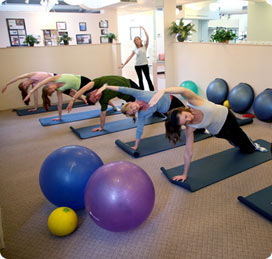 1) Be completely invested in your clients’ progress in results. If you don’t invest in them, how can you expect them to invest in you? Take a moment to ask yourself if you’ve seen them make progress in the past two months. If the answer is no, then think of what you can do to program more effectively.
1) Be completely invested in your clients’ progress in results. If you don’t invest in them, how can you expect them to invest in you? Take a moment to ask yourself if you’ve seen them make progress in the past two months. If the answer is no, then think of what you can do to program more effectively.
2) Mutually re-evaluate your clients’ goals. Let them know that you want them to reach their goals, whatever they may be. Additionally, by setting goals together, you can motivate your clients to make their appointments and show up both in body and mind to each and every lesson. After all, we don’t want our clients phoning it in either! Goal setting also allows you, the instructor, to create benchmarks which you can then use to chart your clients’ progress. Once they see their own records of improvement, they’re more likely to keep at it.
3) Bring your A++ game to the table every lesson or class, every time. No excuses! We recently had a conversation with our top instructors at Pilates on Fifth, and across the board, we noticed that regardless of teaching style, our best instructors are the ones who are excited about the hour, keep the energy up, and keep their clients moving. Ironically, in doing so (and we all agreed on this!) the hour FLIES by… and that’s never a bad thing, right?
4) Make it ENJOYABLE!!! Exercise is one of the BEST forms of stress relief, so keep that in mind!
All in all, we’ve noticed that our best instructors have not only retained, but GAINED clients, even with this crazy economic climate. Hopefully these tips we’ve provided will help others gain and retain lots of clients, both for group mat classes and for private lessons!!!
PILATES ADVANCED CHAIR EXERCISES
Kimberly & Katherine recently taught the PAI’s Advanced Chair Course, Chair Progressions & Challenge to a group of fabulous Pilates instructors here at our Pilates studio in NYC. This was an in-house course for our newer and most promising instructors. For Katherine & Kimberly, it was an absolute blast to teach, and the instructors thoroughly enjoyed it as well. We currently have quite a few Pilates Reformer & Chair classes on the schedule at the studio, and so now participants can anticipate even more exciting variety with new chair exercises being introduced in almost every class.
Pilates Chairs today have all been developed from Joseph Pilates original design of the Wunda Chair. All chairs have a platform, with a pedal to which springs attach to either support body weight or create resistance. Joseph Pilates original chair also double as actual furniture. Click here for more information.
Advanced Chair exercises are a FABULOUS way to increase strength and power training in a Pilates workout. Because chair exercises involve lifting your own body weight and a lot of isometric contractions, your heart rate escalates…. And we know what that means… more calories burned!!! A skilled instructor can pace the workout appropriately, infusing chair exercises throughout to keep the heart rate at an elevated level throughout the workout.
Anyone interested in Pilates for upper body strength will LOVE the chair, as there are great exercises for the triceps, pecs, deltoids and shoulder girdle stabilizers. The one arm push up, hand on chair is an excellent triceps exercise (and pec!), and the Twist does wonders for the deltoids and the shoulder girdle stabilizers.
We always get questions about the best abdominal exercises and best core strengthening exercises… Enter the Chair! Exercises like Tendon Stretch, Single Leg Extension and Handstand are AMAZING for both abdominal strength and core strength. More importantly, they work your body in different planes of motion, with forces coming from a different plane than usual, giving your neuromuscular system an extra workout as well!
If you have a chair & don’t yet know the advanced exercises for the Pilates chair, visit www.ultimatepilatesworkouts.com. From the shopping cart, you can download full Pilates Chair Workouts or download Pilates Teacher Training Videos on the Pilates Chair. For a monthly subscription, you can enjoy anytime, anywhere online Pilates workouts on the chair. In the not too distant future, we’ll be focusing our energies on a “Build a Workout” feature, with blocks of exercises on all Pilates equipment, including the Pilates chair, that can be mixed and matched to create your own unique workout.
And don’t forget that for free Pilates workouts online simply sign up at www.ultimatepilateworkouts.com as a Basic Member and the Pilates videos will stream directly from your computer!
PILATES AND MUSCLE CONFUSION
One of our viewers recently wrote in, asking us if the principles of muscle confusion can be applied to Pilates. Programs like P90X have soared in popularity due to the emphasis on Muscle Confusion, and their practitioners have seen amazing results. “Muscle Confusion”, most basically, is derived from two training principles: the Specificity of Training Principle and the Overload Principle. Both of these principles can be applied to Pilates so that you will continue to reap all the benefits, including flat abs fast, lean legs and a lifted butt, and a stronger core.
The Specificity of Training Principle states that the body will adapt to the specific demand that is placed on it. If you’re a Pilates beginner, it may take a while for your body to adapt to the new exercises you’ve given it, which is a good thing! You won’t hit an exercise plateau as quickly as someone who is already fit. However, once you’re able to do the Pilates exercises correctly in your class, while you will maintain your current level of fitness if you keep doing your Pilates workout in the same way, in the same order, etc., you will not necessarily get stronger and stronger. This is where the Overload Principle comes into play.
The Overload Principle states that to continually adapt, the body must be placed under a stress that exceeds the body’s current capabilities. In other words, with Pilates exercises, one must continually work at his/her own edge as opposed to work in the range that’s comfortable. (That’s why your instructor is continually cueing you to pull in your abs more, to work more deeply, etc.) This is also why certain exercises should always feel hard! For example, once your body adapts to “The Hundreds” with your legs bent, you can then straighten the legs, and then proceed to lower them from there…. get it? And with an exercise like “The Teaser“, the possibilities abound! Most Pilates exercises can be made either more difficult or more intense relatively simply.
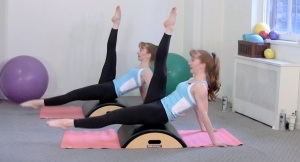 Upon researching more about Muscle Confusion online, we found two interesting articles, one for and one against the idea of muscle confusion. Both have useful tips you can use (or not use!) in your teaching of Pilates. One article (http://www.articlesbase.com/muscle-building-articles/how-the-muscle-confusion-principle-can-maximize-your-workouts-911684.html) LOVES the idea of muscle confusion, stating that even if your goal is NOT to build muscle, (and most Pilates enthusiasts are avoiding muscle bulk) you will achieve your goals much faster applying the muscle confusion principles. On the other hand, the following article (http://ezinearticles.com/?The-Biggest-Muscle-Building-Fallacy-in-Bodybuilding&id=553415) scoffs at the over-emphasis on muscle confusion, pointing out (very convincingly) that if you do not allow your body time to give your brain valuable feedback, then you can’t really accomplish anything. We agree! You need to know where you are to really know where you want to go. Be patient!
Upon researching more about Muscle Confusion online, we found two interesting articles, one for and one against the idea of muscle confusion. Both have useful tips you can use (or not use!) in your teaching of Pilates. One article (http://www.articlesbase.com/muscle-building-articles/how-the-muscle-confusion-principle-can-maximize-your-workouts-911684.html) LOVES the idea of muscle confusion, stating that even if your goal is NOT to build muscle, (and most Pilates enthusiasts are avoiding muscle bulk) you will achieve your goals much faster applying the muscle confusion principles. On the other hand, the following article (http://ezinearticles.com/?The-Biggest-Muscle-Building-Fallacy-in-Bodybuilding&id=553415) scoffs at the over-emphasis on muscle confusion, pointing out (very convincingly) that if you do not allow your body time to give your brain valuable feedback, then you can’t really accomplish anything. We agree! You need to know where you are to really know where you want to go. Be patient!
So, what’s the final answer? YES! You absolutely can apply the principles of muscle confusion to Pilates workouts as well, of course dependent upon the type of Pilates that you are doing. If you are going to a studio where the lesson is exactly the same every time, then, as you pointed out in your email, your body will adapt and eventually plateau to the extent that you stop seeing results. However, if you are continually varying your Pilates workouts and routines, focusing on different muscle groups AND increasing the difficulty level appropriately, then you have effectively introduced the principle of muscle confusion and thus made it impossible for your body to adapt! But remember, whether doing Pilates online or in a studio, you don’t want to change things up too quickly!! Give your body enough time to give you valuable feedback.
For those of you who are utilizing our website for Pilates online, www.ultimatepilatesworkouts.com, we recommend balancing your  workouts between total body workouts and targeted workouts, such that are found in the Strong, Svelte & Savvy Series. If you were to do one of the longer total body workouts on one day, and one of the targeted workouts for arms, legs, butt, back, etc., on alternate days, and then throw in some cardio 2-3 times a week, your muscles would be confused, but balanced and happy as well! Keep the same Pilates training routine for 2-3 weeks, then increase the difficulty.
workouts between total body workouts and targeted workouts, such that are found in the Strong, Svelte & Savvy Series. If you were to do one of the longer total body workouts on one day, and one of the targeted workouts for arms, legs, butt, back, etc., on alternate days, and then throw in some cardio 2-3 times a week, your muscles would be confused, but balanced and happy as well! Keep the same Pilates training routine for 2-3 weeks, then increase the difficulty.
Incorporating props is another way to keep your muscles COMPLETELY confused! The stability ball, foam roller and BOSU(R) will introduce new challenges with both core stability and strength, while the Pilates Ring and Stretch Band can be used to intensify the workload of certain muscle groups and simulate the Pilates equipment, respectively. It’s all about how you put everything together!!
The bottom line is, even if you find a Pilates video or Pilates DVD that you love, don’t do the same one all the time!! Our site has over 25 free mat workouts, so we encourage people to try different ones so that different muscle groups are continually being worked and challenged, and new exercises are continually being introduced. Our new Pilates iphone app (debuting soon!!) will have workout plans included, so follow one of those for great success!
Katherine and Kimberly Corp on Ella Speakes!
Kimberly and Katherine Corp were guests on the Ella Speakes show on Monday, January 11, 2009. They spoke about Pilates on Fifth and what is was like to own a small business in 2009, complete with the challenges and opportunities for growth and change that 2009 did provide. You can find more information about her radio show, which is broadcast in the Oklahoma City area, at this link: http://radiotime.com/program/p_124073/Ella_Speakes.aspx .
Ella is one of the most gracious hosts we’ve worked with, and she generously informed her listeners of not only our studio, Pilates on Fifth, and our Pilates video podcast, but also our Ultimate Pilates Workouts website. We were able to speak in detail about everything our  Pilates workouts site has to offer, and especially how to do Pilates correctly as well as Pilates for beginners. We highlighted Pilates exercise routines such as the Pilates Morning Low Back Care Workout, My First Pilates Workout for Pilates beginners, as well as the Pilates Pink Ribbon workout, for survivors of breast cancer. We stressed that the sort function on the site allows users to sort not only by duration, but also by LEVEL. If you’re doing Pilates at home, you can select the level that’s completely right for you!
Pilates workouts site has to offer, and especially how to do Pilates correctly as well as Pilates for beginners. We highlighted Pilates exercise routines such as the Pilates Morning Low Back Care Workout, My First Pilates Workout for Pilates beginners, as well as the Pilates Pink Ribbon workout, for survivors of breast cancer. We stressed that the sort function on the site allows users to sort not only by duration, but also by LEVEL. If you’re doing Pilates at home, you can select the level that’s completely right for you!
Finally, we encouraged Ella’s listeners to utilize our podcasts so that they know if they’re doing an exercise correctly. From our podcasts 

 page, look on the right side of the page for the list of exercises that have been covered. From there, just look for the name of the exercise that you’d like to review! It’s really that simple.
page, look on the right side of the page for the list of exercises that have been covered. From there, just look for the name of the exercise that you’d like to review! It’s really that simple.
Ella was also kind enough to encourage her listeners to send in their testimonials, and even send us “before” pictures so that once you’ve embarked on your Pilates journey, you can follow it up with a fantabulous “after” picture with a story of your Pilates experience! Feel free to friend us on facebook or send us an email at info@ultimatepilatesworkouts.com. We look forward to hearing from you.
Many, many thanks to Ella Speakes for having us on her fabulous show!
The New Year and Resolutions
Happy New Year!!!
 Now is the time of year that everyone flocks back to the gym, the personal trainer, the Pilates class, or the yoga studio after weeks, or even months of abandoning the regular “routine”. At our Pilates studio, we too are jumping on the Resolution bandwagon with the implementation & promotion of “Fit & Fabulous in 50 Days!”, assuming, of course that 50 days would be about the time it takes to make a lifestyle change. Actually, it’s very easy to resolve to make a change, either by deleting or adding something to our lifestyle, but how easy is it to MAKE the change?
Now is the time of year that everyone flocks back to the gym, the personal trainer, the Pilates class, or the yoga studio after weeks, or even months of abandoning the regular “routine”. At our Pilates studio, we too are jumping on the Resolution bandwagon with the implementation & promotion of “Fit & Fabulous in 50 Days!”, assuming, of course that 50 days would be about the time it takes to make a lifestyle change. Actually, it’s very easy to resolve to make a change, either by deleting or adding something to our lifestyle, but how easy is it to MAKE the change? 
Well, we decided to do a little poking around, and we found a number of sources that stated, and with a great deal of “authority” at that, that it takes 21 to 28 days to change a habit. By this logic, if all of us can just stick with our new routines, whatever they may be, until January 31 or so, then we’ll have no problem keeping our resolutions until the end of the year. …Yeah, right! We all know that it’s not so easy!!
 So, we continued to search for other articles about habits, and habit forming, and we came across this one (click here!) We highly suggest that you read it,
So, we continued to search for other articles about habits, and habit forming, and we came across this one (click here!) We highly suggest that you read it,  but this article sites a study in which it took some participants UP TO 245 DAYS to change their habits!!!! The average was around 66 days. Well, if 66 is the average, then maybe we’re not too far off with our 50 day plan!
but this article sites a study in which it took some participants UP TO 245 DAYS to change their habits!!!! The average was around 66 days. Well, if 66 is the average, then maybe we’re not too far off with our 50 day plan!
At our studio, because we offer not only Pilates (Pilates mat classes and Pilates Reformer classes, yay!), but also XTEND™, CARDIOLATES®, GYROTONIC®, and ActivCore, we figure we have enough in one location to keep even the most ardent sufferers of ADD satisfied and entertained! Couple that with the whole idea of muscle confusion that has become popular,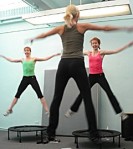 and our New Year’s Resolution plan should really kick off the New Year right!!
and our New Year’s Resolution plan should really kick off the New Year right!!
We’re actually looking for 10-12 people who want to be case studies at our Manhattan Pilates studio! If you are interested, please send an email to projects@pilatesonfifth.com and please put PILATES NYC in the subject line!!
THANK YOU!!
Katherine & Kimberly
Ground Reaction Force: The source of your power!
 Do you remember learning Newton’s third law in a science or physics class? Don’t worry, we didn’t think so! This is the law that states “for every action, there is an equal and opposite reaction.”
Do you remember learning Newton’s third law in a science or physics class? Don’t worry, we didn’t think so! This is the law that states “for every action, there is an equal and opposite reaction.”
Well, in a nutshell, Newton’s third law explains ground reaction force. When we run, jump, throw something, etc., we push against the ground to get power, and the ground returns the exertion of the force to help us get that power. If this doesn’t make sense at first, imagine trying to throw a ball while treading water in a deep pool. Clearly, without a stable surface to push against with the legs, a person in a pool could not propel the ball the distance he could if he were standing on firm ground. In a pool, the legs and torso can do relatively little to help, so the shoulder, elbow and wrist joint must produce the majority of the force necessary to throw the ball.
If muscles in the hips and legs, particularly the gluteus medius, are weak or injured, then the scenario on land is not much better than that in water! When we push against the ground and the ground returns the exertion, the joints of our bodies must transmit this force in the best anatomical and most efficient way possible. In other words, all the muscles of the body must be recruited at the right time to accomplish the task at hand. Muscles must “fire” sequentially to prepare the body to hit the ball, leap the hurdle or perform the double back flip with a twist. Thus, if any muscle along the kinetic chain is weak, underused or injured, then the transmission of forces will be inefficient and faulty, and other body parts must take on more work to make up for the “weak link.”
Using the tennis serve as our example (see chart below) 54% of the ball’s speed should come from the trunk and back, hips and legs. Fifty four percent! This means that before the shoulder even becomes involved in the serve, the body from the shoulders down generates more than half of the power that gives the ball its speed. Of course the remaining power comes from the upper body: the shoulder joint is responsible for 21% of the power, the elbow, 15% and the wrist, 10%.
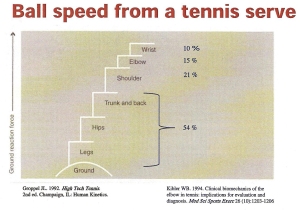
If the gluteus medius is weak, the torso, back, shoulder, elbow and wrist compensate for the lack of power by taking on more of the force. As discussed in a previous blog, the gluteus medius is a key stabilizer of the hip, especially when the weight is on one leg. When “winding up” for the serve, the body’s weight is on the same leg as the serving arm. The muscles are loaded with power and funneled into an explosive serve. A weak gluteus medius results in decreased power and INCREASED potential for injuries. In fact, research shows a weak gluteus medius contributes to shoulder and elbow injuries not only in tennis but in baseball, swimming and golf as well.
What can you do? Well, strengthen your gluteus medius of course! In our previous blog, we listed all the Pilates exercises that are great for doing just this, “Side Leg Lift Series,” “Side Lying Scissors,” “Side Lying Clam and Book,” etc. But, unfortunately, if the firing pattern for hip abduction is faulty, the TFL (tensor fasciae latae) fires BEFORE the gluteus medius. Ideally, the gluteus medius fires before the TFL, but the reverse is true for many people. No matter how fabulous a Pilates instructor you are, teaching someone NOT to use a muscle is far more challenging then teaching them to use one!
This is where ActivCore is absolutely ideal! Because the Redcord system allows for the off-weighting of clients, chronic “misfiring” during hip abduction can be remedied without complex imagery, vocabulary or body awareness. The reduced load enables the client to perform hip abduction with the proper sequencing of muscle firing. Pictures 1 and 2 below shows the regular Side Lying Abduction exercise and pictures 3 and 4 shows the same exercise off-weighted. For more information on ActivCore or the Redcord system, please visit their respective websites at www.activcore.com and www.redcord.com. If you would like to enroll in the teacher training for ActivCore, please visit our teacher training page for upcoming training dates!
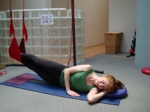
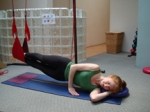
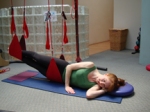
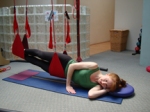
The “other” Glutes!
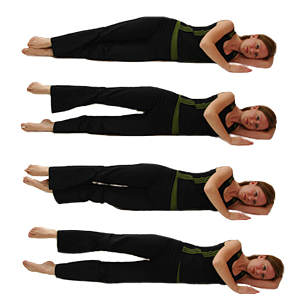 In our last blog, we discussed the merits, both aesthetic and anatomical, of a well developed gluteus maximus (click here to read!). But since the “glutes” do get lopped together often in cueing, today’s blog will discuss their differences and similarities.
In our last blog, we discussed the merits, both aesthetic and anatomical, of a well developed gluteus maximus (click here to read!). But since the “glutes” do get lopped together often in cueing, today’s blog will discuss their differences and similarities.
First of all, the gluteus maximus is the most superficial of the three and gives the buttocks is lifted, curvy shape (when well toned, of course.) Underneath the gluteus maximus lies the gluteus medius and underneath that lies the gluteus minimus. Their sizes are in the name: large, medium and small respectively. If the gluteus maximus gives overall shape to the buttocks, then the gluteus medius and minimus can be said to give shape to the hip.
The gluteus maximus extends and laterally rotates the femur at the hip, and is responsible for bringing the torso upright from a stooped position when standing. The gluteus medius and minimus ABduct the femur, but primarily stabilize the body when standing on one leg. In fact, an often used “weak link” test to determine a weak gluteus medius is to see if the subject can balance on one leg. If the gluteus medius isn’t firing properly, the subject can not stabilize the body on one leg at all. Additionally, both the gluteus medius and minimus assist in medially rotating the femur. However, once the hip is flexed to ninety degrees, the action of the gluteus medius shifts and it aids in laterally rotating the femur.
In Pilates mat work, the gluteus medius and minimus get their moments in the sun during the Side Leg Lift series of exercises. This includes Side Kicks, straight forward Side Lying Abduction of the femur, Side Lying Scissors, Side Lying Bicycle, Banana, and the side lying exercises with the exercise band, Side Lying Clam and Book. However, this pair of muscles is always stabilizing in any standing exercise on the chair or cadillac and in footwork on the reformer, to name a few.
Because the Tensor Fascia Latae also abducts the hip, targeting the gluteus medius and encouraging it to fire first (as it should) can be challenging. ActivCore and the Redcord system offer fabulous exercises for strengthening the gluteus medius safely and effectively. Because of the unique off-weighting system, ActicCore provides direct, acheivable gluteus medius conditioning exercises that can help even the most body UN-aware person isolate the gluteus medius and strengthen it. A strong gluteus medius improves Ground Reaction Force which helps distribute forces evenly through the body during actions such as the tennis serve (click here to read more) and the baseball swing.
More on the gluteus medius and Ground Reaction Force next time!
Why We Love Props For Pilates
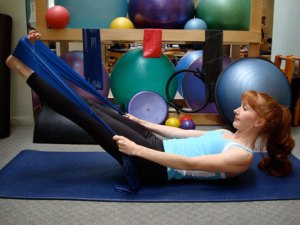 From exercise bands to BoSUs to stability balls, props can add challenges, assistance or variety to a regular Pilates workout. The right prop can make a hard exercise easier and a simple exercise extremely challenging! Targeted use of props can also help spice things up for clients who have been practicing Pilates for years and need a little pizzazz thrown into their workout.
From exercise bands to BoSUs to stability balls, props can add challenges, assistance or variety to a regular Pilates workout. The right prop can make a hard exercise easier and a simple exercise extremely challenging! Targeted use of props can also help spice things up for clients who have been practicing Pilates for years and need a little pizzazz thrown into their workout.
So why do we love props? The first reason is simple and perhaps the most important: props help facilitate the proper execution of an exercise. They help clients achieve neutral, fire into the “right” muscle group and activate dormant muscles that have not been doing their job! Pads and cushions help clients begin an exercise in as close to neutral alignment as possible, which is essential for a biomechanically correct, pain-free Pilates practice. We would not survive at our New York studio without pads to place under clients’ heads to bring the cervical spine into proper alignment when supine or cushions for them to sit on to bring the pelvis into neutral. Pilates Rings and Small Balls between the ankles or knees on certain exercises can help engage inactive inner thigh muscles and help clients deepen their abdominal contraction. Arc Barrels or BoSUs can be effective teaching tools for prone spinal or hip extension exercises. Placing the lumbar spine in flexion on the barrel helps deactivate the often over-active erector spinae of the lower back and can help clients isolate the erector spinae of the upper back or activate the hip extensors without going into lumbar extension.
Second, props help build the strength or awareness necessary to perform the “real” exercise properly. The original Pilates exercises are fabulous and effective on their own, but some people just can’t do them right….yet! Props can be the stepping stone a client needs to succeed in a Pilates mat environment. The “Roll Over,” for instance, can be challenging for many individuals who lack either abdominal strength or spinal flexibility (or both)! By performing the “Roll Over” on an Arc Barrel and beginning with the hips elevated, the client can build the strength necessary to execute the exercise properly without using momentum and jeopardizing the lower back. Similarly, for those with tight lower backs (such as the authors here), the “Roll Up” can be absolutely lovely holding a 4 lb mini-body bar. Of course one needs to be careful with the shoulder girdle given the extra weight, but this little bit of extra weight adds leverage where it is needed to assist with articulation of the spine through the tight spot. As another example, those clients seeking to transition from “Hundreds” with bent knees to “Hundreds” with straight legs but still find maintaining a strong imprint challenging benefit from using an exercise band around the feet. The band helps support the weight of the legs, and thus allows the abdominal muscles to build the strength necessary to maintain imprint, protect the lower back and support the lower body simultaneously.
Finally, we love props because they introduce muscle confusion training into a Pilates mat workout, which helps any body get more out of their Pilates routine. Simply put, the muscle confusion training principle states that muscles adapt to a specific type of stress and need to be challenged in varied ways in order to continue experiencing results. Muscles improve from being subjected to new and different stresses and challenges which is exactly what props can provide. Athletes cross train for this very reason, as the body benefits overall from allowing certain muscles fibers to rest and others to engage. Moreover, incorporating props into a Pilates workout can help prevent the well-known plateau effect and even boost clients over a “road block” that keeps them from progressing. Use of props can kick up the intensity of the workout quite effectively without placing undue strain on the body. In fact, research shows that something as simple as performing a bench press on a stability ball is 62% more effective than a bench press with the same weight conducted on a regular bench. (Source)
 Furthermore, muscles performing the same action day after day “get bored” just as clients get bored with the same workout! Varying a workout ensures that clients continue to see results and stay interested. Pilates enthusiasts who regularly work out on the Pilates equipment already benefit from the muscle confusion training practice as integrating all equipment into sessions over the course of a week or month allows muscles to perform in different ways each workout. Thus, just as “Side Bends” activates different muscles groups on the Ladder Barrel, Cadillac and Mat, so to does “the Hundreds” challenge the body in different ways using the Stretch Band, the BoSU and the Pilates Ring. Focusing on different muscle groups and adding variety will not only enhance core stability, but also turn your Pilates routine into a fabulous cross-training program, which will improve your overall fitness and decrease your risk of injury. (Source)
Furthermore, muscles performing the same action day after day “get bored” just as clients get bored with the same workout! Varying a workout ensures that clients continue to see results and stay interested. Pilates enthusiasts who regularly work out on the Pilates equipment already benefit from the muscle confusion training practice as integrating all equipment into sessions over the course of a week or month allows muscles to perform in different ways each workout. Thus, just as “Side Bends” activates different muscles groups on the Ladder Barrel, Cadillac and Mat, so to does “the Hundreds” challenge the body in different ways using the Stretch Band, the BoSU and the Pilates Ring. Focusing on different muscle groups and adding variety will not only enhance core stability, but also turn your Pilates routine into a fabulous cross-training program, which will improve your overall fitness and decrease your risk of injury. (Source)
With all the props available today, one can quickly become overwhelmed when deciding which props to choose. Is your goal to challenge your client? Help her do an exercise correctly? Target his core? Facilitate better alignment? Knowing the merits of each prop and which ones best suit your clientele’s objectives is the first step to integrating props successfully into your Pilates workouts. We have included a chart below to highlight the various benefits, but please keep in mind that the categories are exercise specific! The exercise band, for example, can assist the “Roll Up” but challenge the “Double Leg Stretch.” Also, one very dangerous trap to fall into is watching others use props and then copying them in your sessions. Never EVER use clients as guinea pigs! Incorporating a prop often changes the emphasis of the exercise, so be sure to try the exercise with the prop first before teaching it to an unsuspecting client.
In conclusion, we offer three basic rules of thumb to follow with regard to incorporating props into Pilates workouts. First, choose a prop with a specific goal in mind for the client or class you are teaching. (In other words, do not choose a prop because you, personally, are bored and need some entertainment!) Second, remember that most clients can focus on one thing at one time. Thus, multiple props used simultaneously tend to destroy — rather than enhance — the integrity of the exercise. Though the picture to the right is humorous, you clearly want to avoid this scenario with your clients. Finally, because props do change the original exercise a bit, be mindful of what is gained — and what could be compromised — with the addition of a prop. Shoulder Bridge on the BoSU, for example, helps activate the core because of the instability, but the hamstrings may cramp because of the increased effort required to stabilize.

The Pilates repertoire has not only withstood the test of time, it continues to impress and amaze both the fitness and medical worlds with its benefits. Make sure to honor this system with thoughtful use of props that enhance the client’s overall Pilates experience.
How to work your abs WITHOUT FLEXING YOUR SPINE!
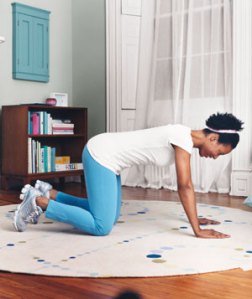 As we wrote in our last blog, when a client asks to “work their abs,” it is very easy to fall into the trap of delivering an hour of flexion exercises. Hearing our clients squeal “oh I feel my abs” is most gratifying, and as we all know, this result is most quickly achieved when many flexion exercises are performed in succession.
As we wrote in our last blog, when a client asks to “work their abs,” it is very easy to fall into the trap of delivering an hour of flexion exercises. Hearing our clients squeal “oh I feel my abs” is most gratifying, and as we all know, this result is most quickly achieved when many flexion exercises are performed in succession.
But for the spine’s long term health AND balance of the muscles in the torso, varying spinal movement is absolutely essential. Additionally, exercises requiring stabilization in neutral add a new dimension of body awareness and abdominal work to a client’s routine. Not only do such exercise help teach a client where neutral is in their own body, but also trains the muscles in the body to support the body there.
For starters, simple exercise like sitting upright, right on top of the sit bones, on the stability ball can start to bring awareness to the abdominal muscles’ role in holding the spine and pelvis in neutral. Once this is mastered, practicing alternating lifting and lowering the legs (we call this “marching”) further challenges core strength.
Every piece of equipment, including the mat, includes exercises in neutral, so don’t forget to include them in your clients’ sessions. The Reformer and Cadillac provide many exercises in which the spine is stabilized in neutral against the movement of the arms and legs. These exercises can be modified for all levels, so beginning and advanced clients alike can benefit. The Chair, on the other hand, offers many “neutral” exercises, but given the balance and core strength required for many of them, these exercises may not be the most suitable for the first session (depending on your client’s strength and ability, of course.)
Personally, we LOVE the prone exercises on the chair! One of our biggest problems to this day is popping ribs, and the prone chair exercises help bring awareness to the muscles we need to use ALWAYS to prevent this from happening. Because the weight of the legs is unsupported in this series, you can try backing the chair up to the Cadillac (providing your Chair and Cadillac bed are the same height) so that the client’s lower body is fully supported if necessary. Likewise, side lying exercises on the Cadillac and Barrels are excellent ways to work all four layers of the abdominal muscles while working the legs or arms, depending on the exercise.
In fact, we encourage all readers to challenge themselves to incorporate at least 10 “stabilization in neutral” exercises into all of their sessions this week. If you have a client with a disc injury (a herniation, etc.), you are surely an old pro at this! If you have not yet HAD to program this way, staring now when it is “fun” is an excellent way to prepare for the client you will have – one day – who can not flex his/her spine.


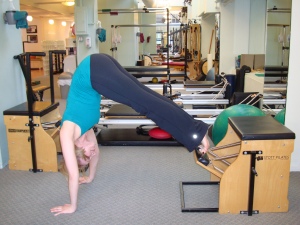




You must be logged in to post a comment.